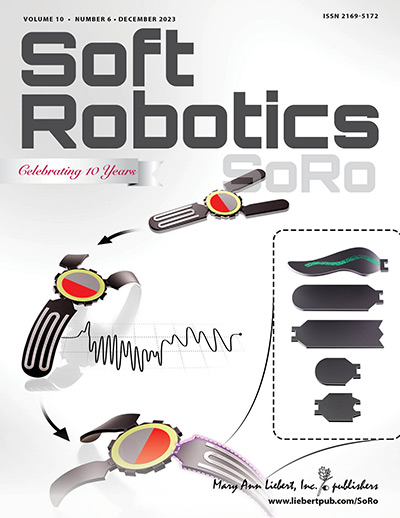Far-Field Magnetic Sensing on Soft Origami Actuator for Spatial Multidimensional Movement and Force Perception.
IF 6.1
2区 计算机科学
Q1 ROBOTICS
引用次数: 0
Abstract
Soft robots exhibit exceptional flexibility and adaptability, enabling them to dynamically adjust their body shapes in unstructured environments for a wide range of applications. This motivates an extensive investigation of soft sensing techniques to accommodate such versatility. Magnetic sensing mechanisms present promising adaptability for soft robots due to their ease of integration and extensive detection range features. In this study, we explore the potential of utilizing far-field magnetic sensing in combination with a soft actuator model-based approach for multimodal perception. We introduce a Soft Farfield Magnetic Origami design, which incorporates a concise Hall sensory array into soft pneumatic origami actuators. The Hall sensory array is utilized to track the unique distal position of the soft actuator. This facilitates the further retrieval of spatial multidimensional movements, including linear and omnidirectional bending motions, as well as interactive forces. This multimodal sensing capability is supported by the modeled relationships between the desired sensing modalities and the measurable set of soft origami actuators, in terms of distal position and pressure. Our proposed approach showcases accurate spatial kinematic perception with a root-mean-square deviation of 0.36 mm in length, 0.02 rad in angle, and an interactive force variation detection with a root-mean-square deviation of 0.89 N. This comprehensive methodology from concept, modeling, design, and fabrication, to validation, facilitates position feedback control and interactive force tuning in soft robotic systems.软折纸驱动器空间多维运动与力感知远场磁传感。
软机器人表现出卓越的灵活性和适应性,使它们能够在非结构化环境中动态调整其身体形状,以实现广泛的应用。这激发了对软测量技术的广泛研究,以适应这种多功能性。磁传感机构由于其易于集成和广泛的检测范围的特点,在软机器人中具有很好的适应性。在这项研究中,我们探索了利用远场磁传感与基于软致动器模型的多模态感知方法相结合的潜力。本文介绍了一种软性远场磁折纸设计,该设计将简洁的霍尔传感阵列集成到软性气动折纸执行器中。利用霍尔传感阵列跟踪软执行器的独特远端位置。这有助于进一步检索空间多维运动,包括线性和全方位弯曲运动,以及相互作用的力量。在远端位置和压力方面,所需的传感模式和可测量的软折纸驱动器之间的建模关系支持了这种多模态传感能力。我们提出的方法展示了精确的空间运动学感知,长度均方根偏差为0.36 mm,角度为0.02 rad,交互力变化检测均方根偏差为0.89 n。这种从概念,建模,设计,制造到验证的综合方法,促进了软机器人系统的位置反馈控制和交互力调谐。
本文章由计算机程序翻译,如有差异,请以英文原文为准。
求助全文
约1分钟内获得全文
求助全文
来源期刊

Soft Robotics
ROBOTICS-
CiteScore
15.50
自引率
5.10%
发文量
128
期刊介绍:
Soft Robotics (SoRo) stands as a premier robotics journal, showcasing top-tier, peer-reviewed research on the forefront of soft and deformable robotics. Encompassing flexible electronics, materials science, computer science, and biomechanics, it pioneers breakthroughs in robotic technology capable of safe interaction with living systems and navigating complex environments, natural or human-made.
With a multidisciplinary approach, SoRo integrates advancements in biomedical engineering, biomechanics, mathematical modeling, biopolymer chemistry, computer science, and tissue engineering, offering comprehensive insights into constructing adaptable devices that can undergo significant changes in shape and size. This transformative technology finds critical applications in surgery, assistive healthcare devices, emergency search and rescue, space instrument repair, mine detection, and beyond.
 求助内容:
求助内容: 应助结果提醒方式:
应助结果提醒方式:


